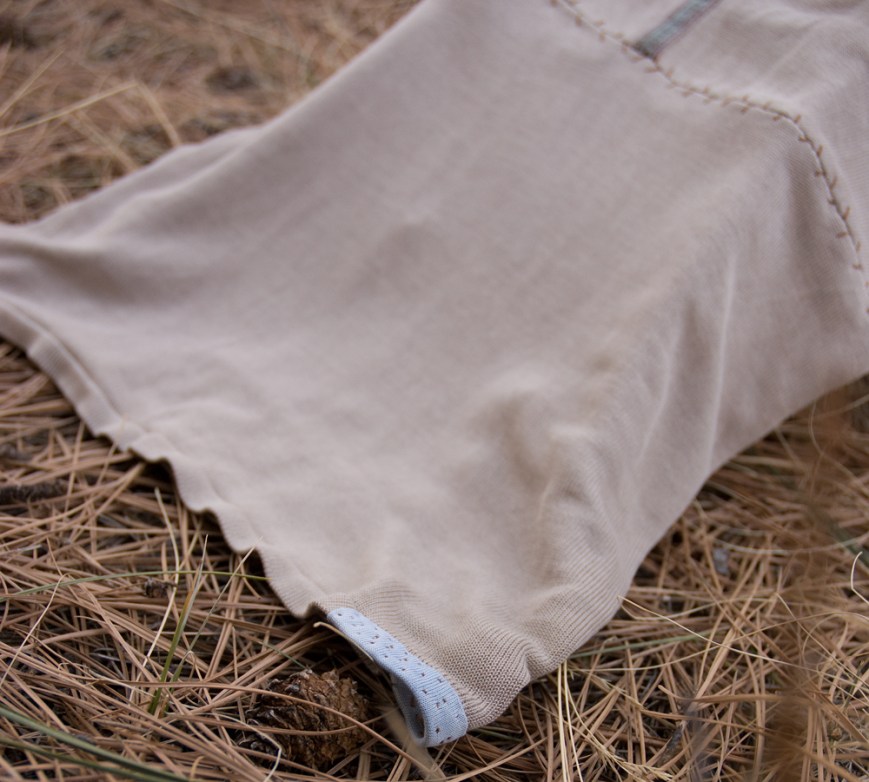
Are you ready for a radical anti-consumerist statement? Here goes: I have enough clothes. Now, this isn’t a terribly original radical idea, even among other makers & sewists (for one, Felicia wrote eloquently about it last summer). But it’s an idea that I’ve been rolling around my head for a year or so now, mulling over where I’m going with it, and I think I’ve made some progress.
Roughly six years ago, without really telling anyone about it, I decided that I would get the clothes I needed in my wardrobe by making them instead of buying them. At the time, I needed quite a bit. For winter wear I remember having a total of two long sleeved knit shirts, both plain cotton not-great-fitting ones from the thrift store. Situations like that were part of the reason I went handmade; I was frustrated looking for ready-made clothes I liked that I could afford, and tired of feeling like most of what I wore didn’t suit my personality or my life. Me-Made-May was also essential in getting me going in this direction. Before we move on, I want to acknowledge that it is a great privilege to be able to choose warmer and better-looking clothes. While I’m not always sure what to do with that knowledge, it seems important to say it, and I do think that just acknowledging it helps me be more grateful and mindful of what I have, and encourages me to take care of things and not take them for granted.

This was an old silk cami with a shelf bra inside, made from a thrifted top. As you can see, it had a lot of wear and had already been patched once. But there was still enough sound fabric between the body and the shelf to reconstruct a different cami (below). It’s certainly arguable that this was too much work, too much hand stitching, for a garment which realistically is made from worn fabric and has a limited life expectancy. And yet, it gave me a lot of freedom to experiment, and a functional garment …
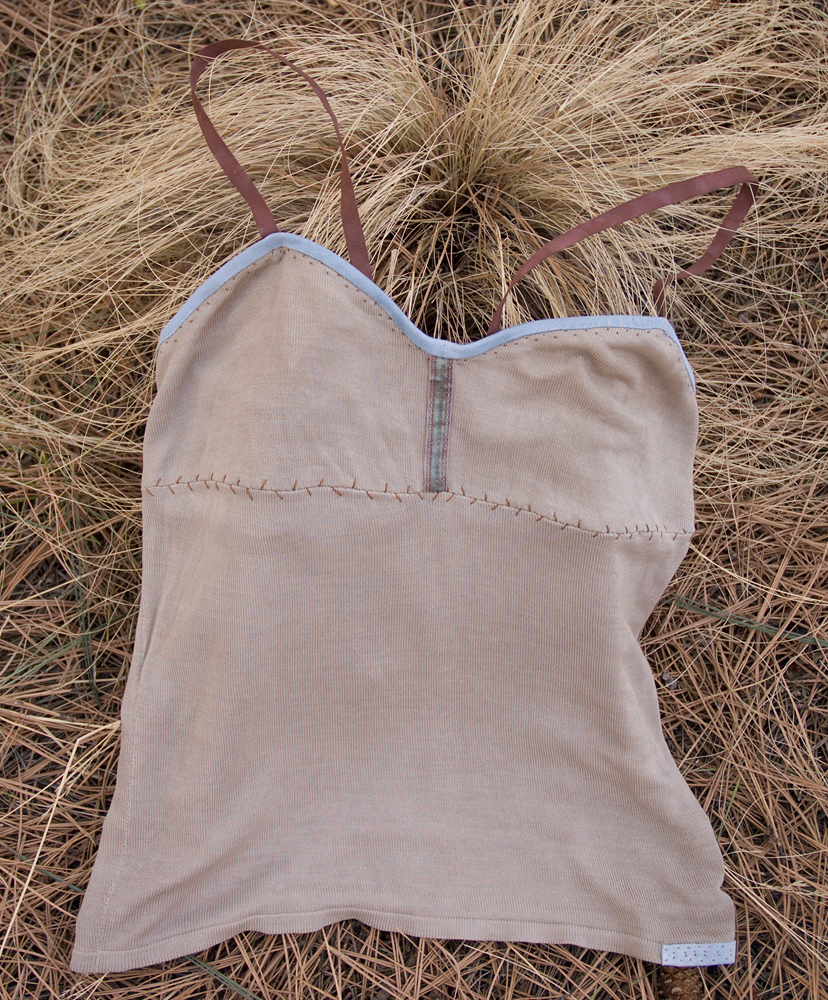
So back then, I just started sewing garments, beginning with what I needed most, and then moving to the next-most-needed thing. It worked—I slowly but surely built a wardrobe of clothes I love, which covers just about any situation in my life. The new things have been mostly me-made, with a few lucky thrifted/gifted pieces mixed in. It certainly helped my progress that I already knew how to to sew (and knit), that I was already thinking about how my style reflects the way I want to be seen, and that I had a fair amount of fabric stashed away (although I certainly acquired more for specific projects).
Because I came into my personal wardrobe sewing revival from a place of making what I really needed, it was unavoidably obvious when I got to the point of not needing much. It’s been a gradual but ultimately fairly profound shift for me; from having a new garment in progress most of the time, to focusing more on slower projects, mending, and keeping my wardrobe in good shape.
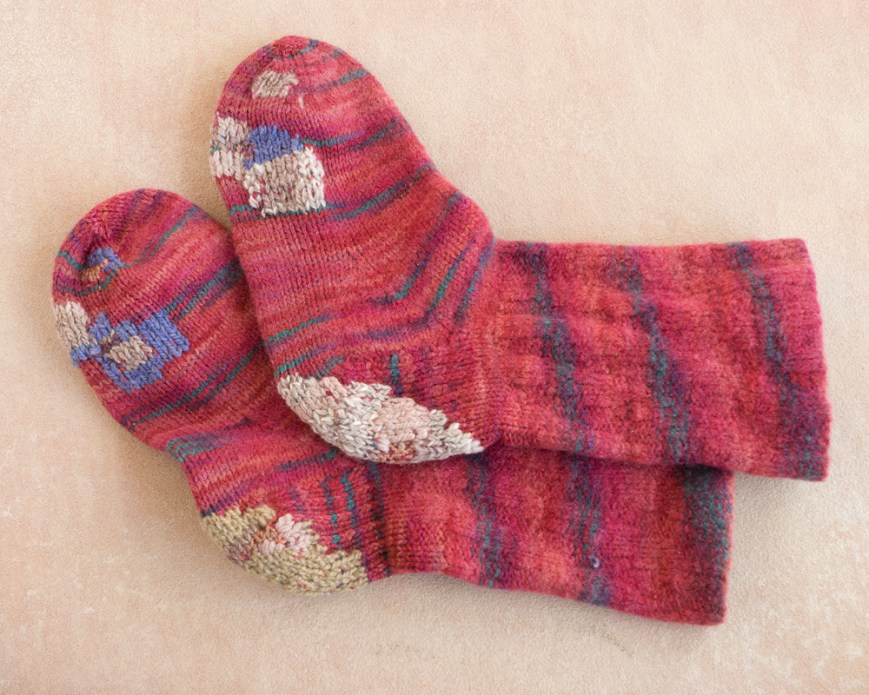
These handknit socks I got from a friend quite a while back are my longest-running mending project. I just can’t give them up. All but one pair are still going.
At first, I was a little conflicted about all this. I thought I might miss sewing things from fresh fabric, or maybe more truthfully that I would miss dreaming things up to sew out of fresh fabric. But, as Jess pointed out, there’s no reason not to keep dreaming. After all, just a small percentage of the garments I imagine ever get sewn, no matter how much I’m actually making. Also, it turns out that for me anyway, it’s just as satisfying to dream up ways to re-make things that have been languishing in the back of my closet or in the “try again” basket. And it’s not that I am making nothing new. Right now I am knitting socks (the world’s slowest pair since I’m only working on them when traveling, plus I keep changing my mind and ripping out the heel …), spinning yarn which will become a sweater in its own sweet time, and plotting a new shirt from my natural-dye-printed fabric. And, I’ve just realized that neither my newer purple corduroys nor my blue cotton pants are really presentable for outside wear anymore—there will always be things to make!
But for the most part, my sewing lately has been directed towards keeping my existing wardrobe going, making it better, and adding in the next level of that message I want to send when people see what I’m wearing. At some point it occurred to me that while I know I’m wearing handmade, anyone who sees my clothes (especially if they don’t sew) will just assume that I bought them somewhere, like “everyone” does. In fact, many a sewist’s goal has been to make clothes that look “just as good” as store-bought ones. Well, I’ve decided that I’d actually like people who see me on the street to think to themselves, “Hey, I wonder if she MADE that … or someone did …”—in a good way, of course! I’m interested in adding more hand stitching, more hand-dyed fabrics (and eventually handmade fabrics?!), and definitely interested in wearing visible mending proudly on the outside of my clothes.
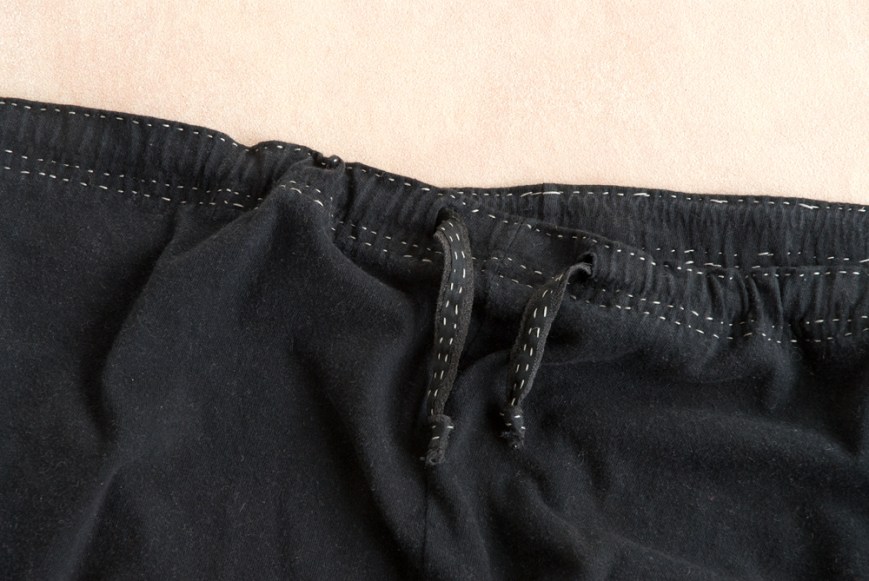
Rather than making a new pair of PJ pants when I needed some recently, I decided it made more sense to revamp a pair that Bryan wasn’t wearing. That meant getting rid of crumbling elastic, and adding enough hand stitching that they felt like “my new comfy beautiful PJs” rather than “this hand-me-down thing I’m stuck with.”

This downshift in sewing fits in really well with other shifts in my life over the past couple of years. A lot of my creative energy has been and is now going into thinking about natural dyes, fibers, and fabric printing. As I’ve taught those skills more widely, I’ve been working hard to learn all I can and improve my process. (It’s the biggest, deepest, best rabbit hole of research and experiments I’ve ever been in.) I’m teaching mending more too, so it’s been perfect timing for me to take on mending my own wardrobe as more of a deliberate project, seeing how far I can push things and what I will learn by continuing to choose “fix it” over “rag bag.” As much as I am devoted to other textile arts, it pops into my head over and over again that mending is probably the most valuable, most potentially world-changing thing I could do, show, or teach. (Come join me! New classes recently added.)
I think it’s also worth noting that I’m more comfortable in this stage of my evolution as a maker because of the type of maker I am. While I certainly try to master the skills I take on, every textile technique I learn about fascinates me, and I’m always ready to expand my horizons. So spending less time sewing ultimately means I’ll have more time for dyeing, spinning, maybe some weaving, or to try something else entirely new—a bonus in my book.
This blog has evolved with me, and I want it continue to do so. I have plans to start sharing some of what I’ve learned about natural dyeing here, as well as whatever else comes up. So for now, a happy season to you, whatever yours may be. (The monsoon rains just started here, and I am so very grateful!)
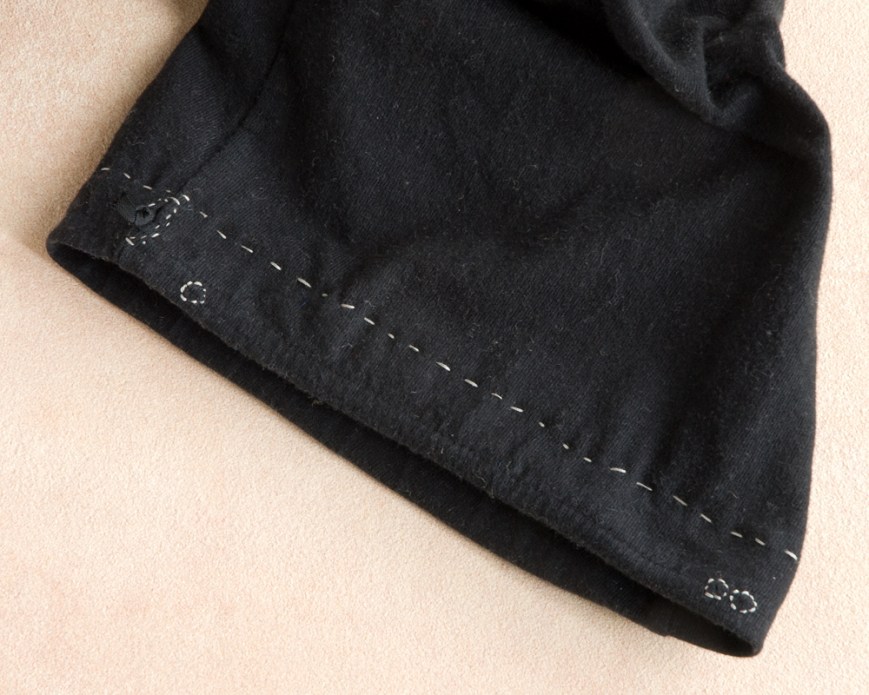

Tasha, I have had a terrible day and your blog post was just what I needed! Thank you. I have been talking about buying less and making and mending more for awhile now and it is wonderful to see more people saying just that. And I love your silk cami, it is lovely! I have some churro fleece that I have been spinning and intend to knit into a vest for the grandson that lives with me. And now he tells me he wants me to dye it! It’s a lovely soft natural brown and over- dying might work nicely on it! I dyed some homespun with turmeric a while back and he wants that. Hmmm, over light brown churro, I’ll have to think about that! You are very inspiring, Tasha, and I always enjoy reading your blog. I’m looking forward to hearing more from you!
Thanks Heather! Reading these comments gave a boost to my day too. I love that you’re working through a project with your grandson and he gets to see all the steps. If I were you I might pick a more lightfast natural dye than turmeric, maybe weld or rabbitbrush? Good luck!
Thank you, Tasha, great advice! And rabbitbrush is all over the place here!
Tasha, What a cool post. I love that you found the freedom and insight to not only create your wardrobe, but to mend and care for it. Slow is good and I can see from those garments that they are truly loved–and used! ~Melissa
Thanks Melissa! Yeah, it’s been really interesting to start questioning how long I can really make something last. I definitely have some cultural conditioning that something is “worn out” when it gets the first tiny hole … clearly not true!
Thanks for this. I’ve been undergoing a pretty big shift in my clothes (not suiting my style and stage of life) and have been making for several years now. I want to make sure I’m reusing as much as possible, but it doesn’t always work. I was pondering how best to remake some of my garments that no longer fit or suit me, and this post has given me some ideas and things to ponder going forward. Your post arrived at just the right moment for me. Thanks again.
Wonderful, Juliana, thank you!
Tasha, I love reading your posts and thank you for this reminder! I have been saying that this is the year that I’m going to make a coat… but actually, my slightly ratty black coat does me just fine in warmth, all I need is to replace the missing buttons (perhaps in lovely colours) and add some embroidery around the collar and cuffs, and I’ll have a new(ish) garment! (It’s winter here, if you hadn’t guessed…) I’ve been a little sucked in to making new and exciting things lately, and I think it’s time to sit back and go slow. (And also finish those things, because I think probably a finished dress, that may be unneeded but at least will be worn, is better than a pile of fabric already cut out and only halfway sewn.)
Thanks Rowena! I’ve come to just about exactly the same place with my winter coat actually. It’s worn around the cuffs and front edge, but the rest of the fabric is still good and excellent quality—except for the lining which is just about totally shredded. I have a plan to take it somewhat apart and re-work it, add a new lining etc. when it starts to get cool again here … this is my most ambitious garment remodel yet, we’ll see how it goes … but if it doesn’t work out I can always go back to the plan of making a new coat.
Yours sounds like a little more work needed than mine! The only part of my lining that’s struggling is the pockets, it’s mainly the buttons and just a general sense of boredom from the unrelieved blackness of the fabric.
As always, Tasha, I found your post interesting and enjoyable to read. Unfortunately, though, I never learned to sew or mend, and at this stage in my life, middle-aged, I don’t intend to learn how to sew. But I admire those of you who do. I’ve stopped knitting for now; too hard on my neck and shoulders, plus I’m really not very good! I never get beyond the simple stage where I can understand structure and fix mistakes without someone else’s help, alas.
It’s never too late, Melissa, and in some ways mending is very straightforward compared with knitting … 🙂
Thank you so much for this! While it all resonates, what I appreciate most and needed to hear now is that it’s ok that it’s a slow, ongoing process to get to that ideal, minimal wardrobe. I am only recently accepting that my body has changed (possibly forever) post-babies, and that my needs have changed (must be super crazy comfortable, probably involve elastic, and have pockets!). I feel antsy that I haven’t had time to sew for myself and I don’t want to buy new clothes, so I’ve been hanging out on eBay trying to find used things that will work. But just this past weekend, I was in Denver and splurged on some Alabama Chanin fabric that I can hand stitch into a dress for myself. This is the first new fabric I’ve bought in years, and the first project that is just for me. And now with little people, I can hand stitch here and there more easily than sit in front of my machine.
I *love* your new cami and pj pants – they are wonderful inspiration! Thanks for sharing your thought process as well as your craft process!
I go back and forth about whether posting my thoughts is a good idea, but if you find it meaningful that definitely encourages me to carry on! I think this kind of thing almost HAS to be a slow process—I don’t know of any fast wardrobe shifts which are also sustainable … That Alabama Chanin fabric is well worth supporting. Enjoy your stitching!
Hi Tasha- I always love your ideas and I am inspired by your cami project. I have a pair of socks made by my mother 50 years ago that I keep mending and mending. I think anyone who knits and sews understands how precious handmade items are.
I am chawing on the idea of transforming this knit turquoise top that doesn’t fit into something entirely different. Your ideas keep me thinking….! Love your blog.
Thanks Charmain for the kind words! Yes, my much-mended socks are a patchwork of darning at this point, and show how my skills have improved, still somehow in their wonky state I love them … I was just talking to another textile artist today about how, when you think about it, almost every moment of our whole lives we are touching something made of fabric … the ways that we think about those things and our relationship to them is fascinating to me.
Hello Tasha, its 2021, and I found your blog by googling how to sew merino knit fabric. Delighted I found your blog. The sun is shining outside and I can’t stop reading posts 😊. Checked your etsy shop, but it seems that it’s not much happening there. I hope all is well. Happy St Patrick’s Day and greetings from Ireland 🍀🇮🇪💚